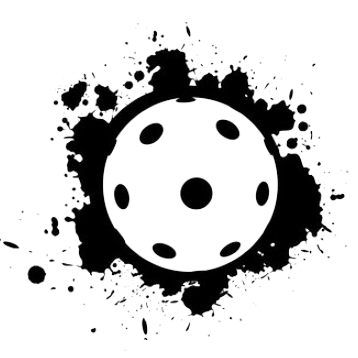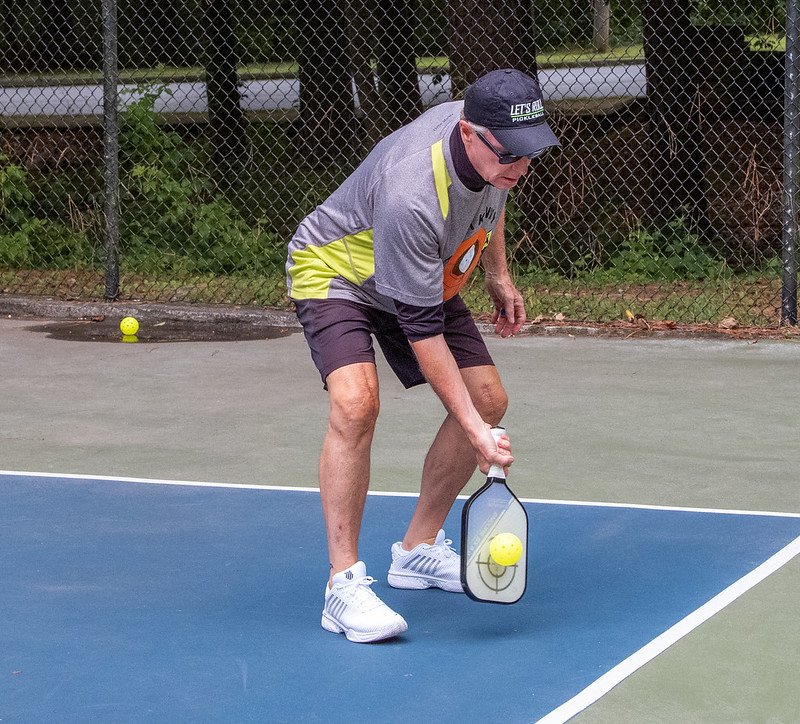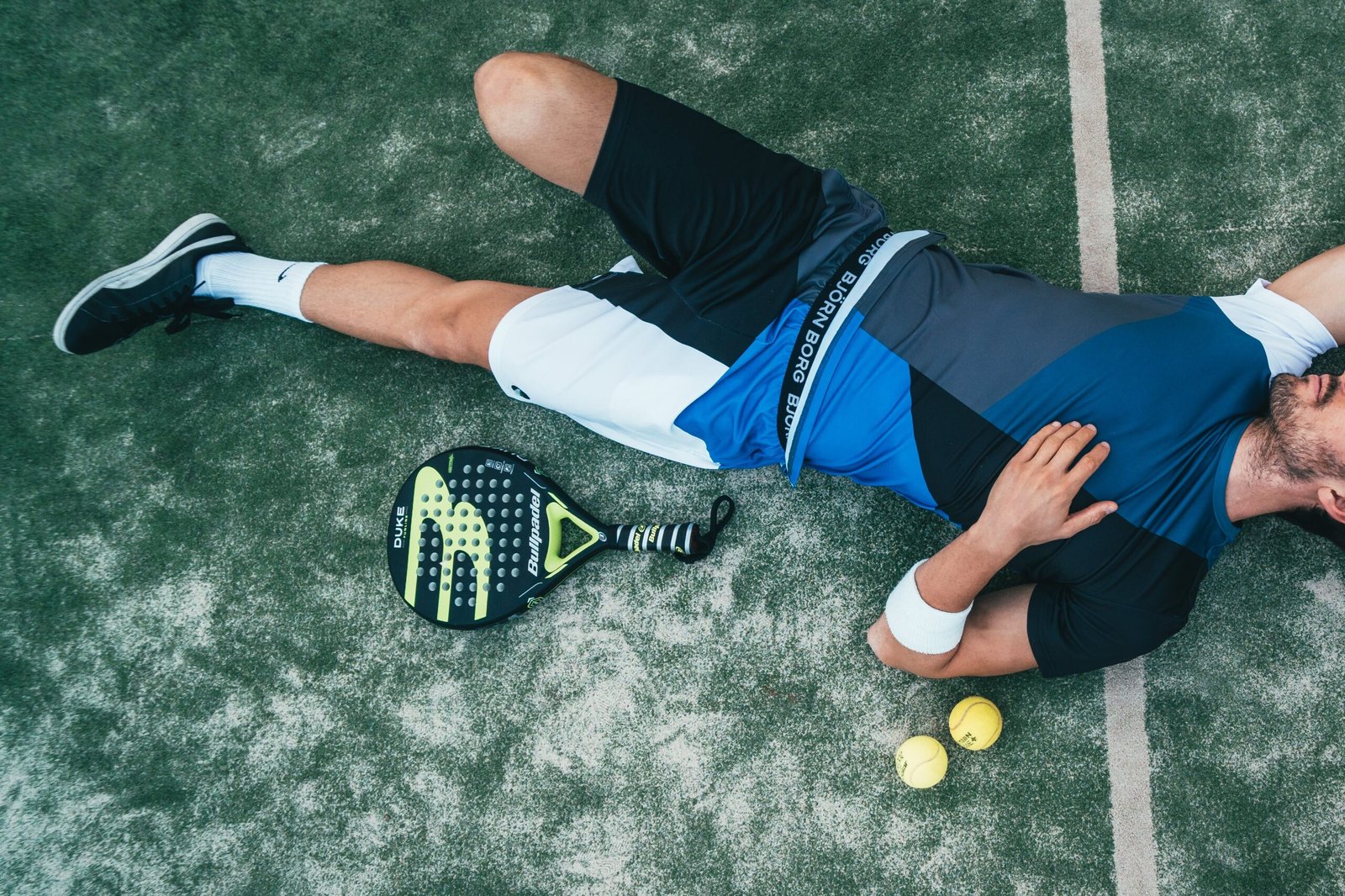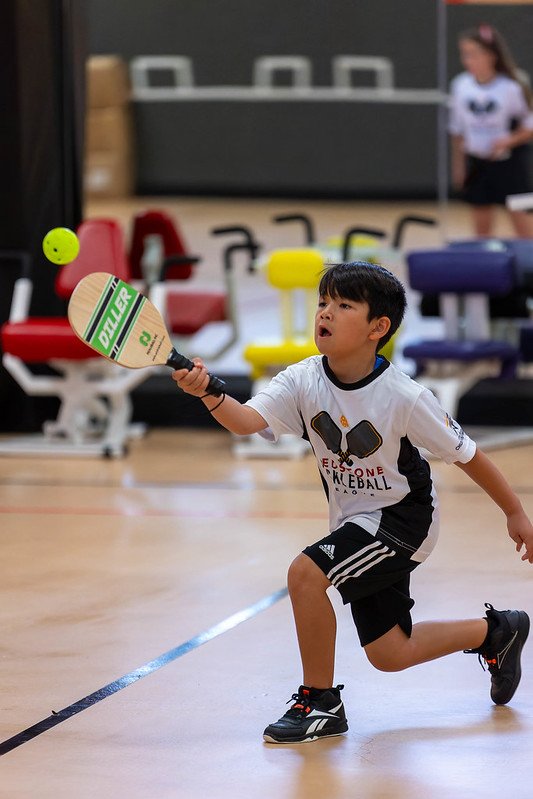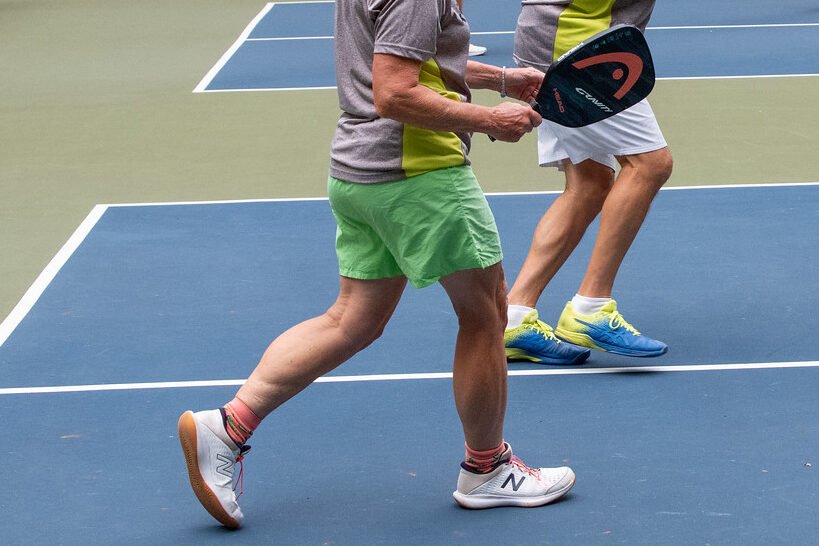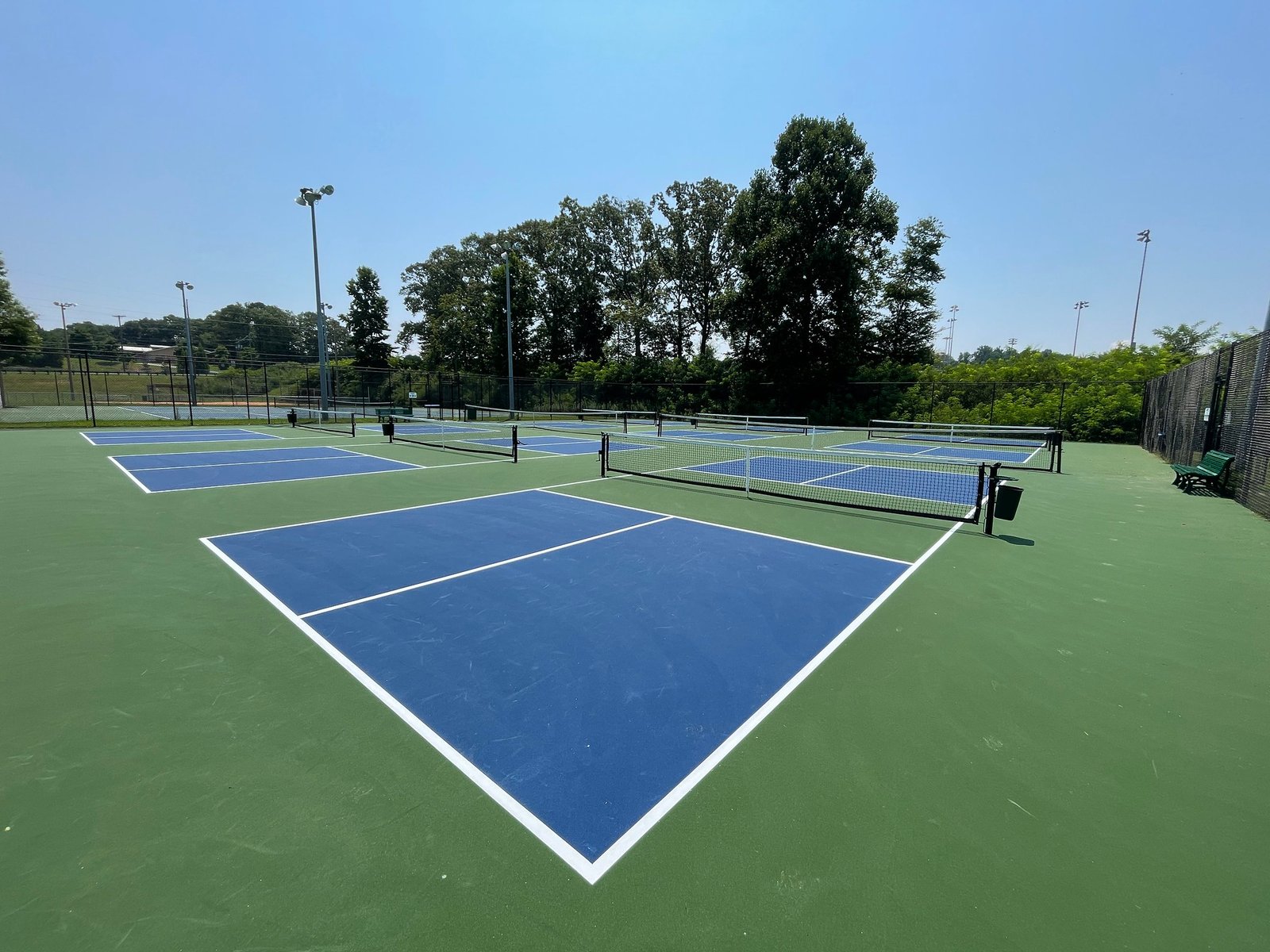Welcome to the comprehensive guide on creating your very own outdoor pickleball court! Whether you’re a pickleball enthusiast seeking a personal court or a community looking to embrace this increasingly popular sport, this guide will walk you through the intricate process of Pickleball court design, DIY Pickleball court construction, and essential considerations for crafting a top-notch playing area.
Pickleball, a dynamic amalgamation of tennis, badminton, and table tennis, has swiftly gained traction worldwide for its accessibility and thrilling gameplay. To truly savor this sport, having a dedicated court readily available is a game-changer. Our guide focuses on turning that dream into a reality, offering insights into every facet of construction, from meticulous planning to the final touches.
Pickleball court design is pivotal for optimal gameplay and safety. We’ll delve into the specifics of court dimensions, surface materials, and ideal layout considerations, ensuring your court adheres to official standards while catering to your individual preferences.
The DIY Pickleball court construction process involves several steps that demand precision and attention to detail. From preparing the ground and marking court boundaries to installing nets and maintaining proper drainage, we’ll cover each phase comprehensively. Moreover, we’ll emphasize budget-friendly methods and expert tips to streamline your construction journey.
Whether you’re a private homeowner seeking a personal recreation space or a community organization aspiring to foster a hub for pickleball enthusiasts, this guide accommodates diverse needs and ambitions. Our goal is to empower you with the knowledge and confidence needed to create a high-quality pickleball court that enhances your playing experience and fosters a love for the game.
Get ready to embark on this fulfilling endeavor and transform your space into a haven for pickleball aficionados. Let’s dive into the nuances of Pickleball Court Construction and set the stage for endless hours of enjoyment and competitive play!
Table of Contents
Can you play pickleball on cement?
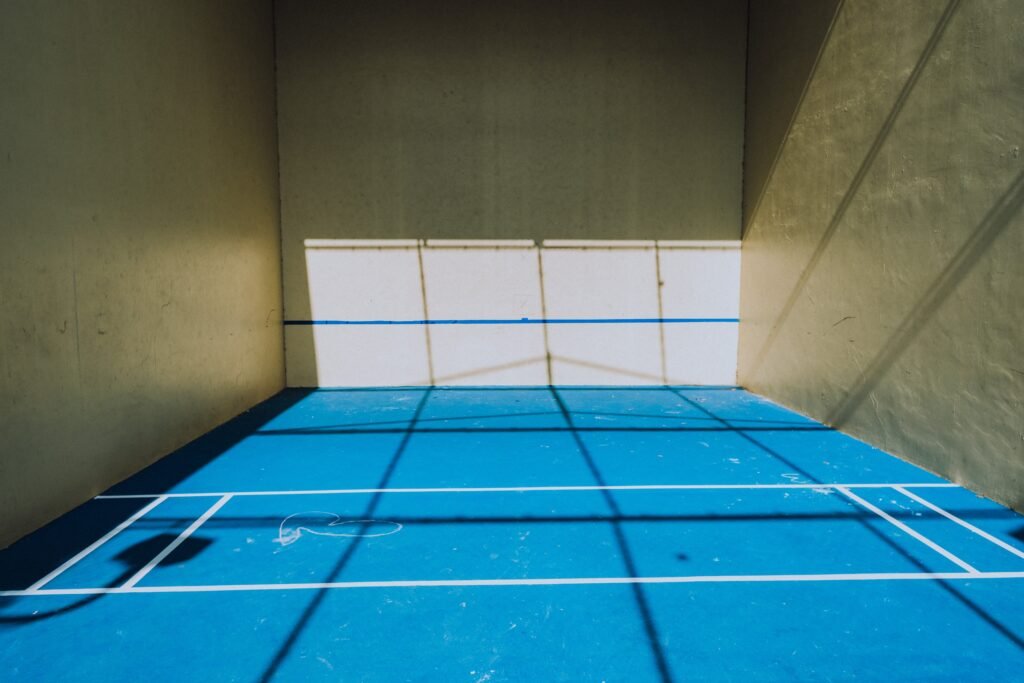
Absolutely, pickleball can be played on cement surfaces, and it’s a popular choice for many pickleball enthusiasts. Cement provides a solid and durable base for playing pickleball, offering several advantages for both casual and competitive gameplay.
The smooth and consistent texture of cement surfaces makes it an ideal choice for pickleball. It allows the ball to bounce predictably, ensuring a reliable and fair playing experience. Unlike uneven or soft surfaces, cement offers a consistent playing field, enabling players to anticipate ball movement and execute shots with more precision.
Cement courts are relatively low-maintenance compared to other surfaces. They are resistant to weather elements like rain and sun exposure, making them suitable for outdoor play year-round. Additionally, maintenance for cement courts often involves simple cleaning routines, ensuring they remain in good condition for extended periods without much upkeep.
One key consideration when playing pickleball on cement is the potential impact on players’ joints. Cement surfaces can be challenging, which might lead to increased strain on joints, especially during prolonged play. To mitigate this, players can opt for appropriate footwear with cushioning and support or consider using court shoes designed to absorb impact.
For communities or individuals seeking to install a pickleball court, cement offers a cost-effective option. It’s relatively affordable compared to other specialized court surfaces like asphalt or synthetic materials. The durability of cement also means that, when properly installed and maintained, it can provide years of playing enjoyment without the need for frequent repairs or replacements.
How much space is needed around a pickleball court?
An essential aspect of constructing a pickleball court involves considering the space around the playing area ensuring adequate clearance for safe and uninterrupted gameplay. The recommended space around a pickleball court is crucial for player movement, safety, and comfort, fostering an enjoyable experience for participants and spectators alike.
For a regulation-size pickleball court, which measures 20 feet wide and 44 feet long for singles and 20 feet wide and 22 feet long for doubles, certain clearances are advised to maintain a suitable playing environment. These recommendations are in place to minimize any obstructions or potential safety hazards:
Sideline Clearances
A minimum of 10 feet on each side is typically recommended to ensure sufficient room for players to move freely and retrieve stray balls without obstruction.
Back and Front Clearances
A minimum of 12-16 feet behind the baseline and 6-10 feet in front of the baseline is recommended. This allows players to maneuver comfortably and retrieve balls without encroaching into adjacent areas or obstacles.
Non-Volley Zone (Kitchen) Clearances
The area extending 7 feet from the net on either side requires clear space. Adequate room in this zone prevents collisions and provides enough space for players to maneuver without stepping into the non-volley zone.
End Line and Sideline Fencing/Barriers
When installing fences or barriers around the court perimeter, it’s advisable to maintain a clearance of a few feet beyond the sidelines and baselines. This helps prevent balls from rebounding off fences and interfering with the game.
Ensuring these clearances is crucial for a safe and enjoyable playing experience. However, available space may vary based on individual preferences, local regulations, or constraints of the surrounding area. Adequate space around the court not only enhances safety but also contributes to the overall aesthetics and functionality of the playing area, accommodating players and spectators comfortably.
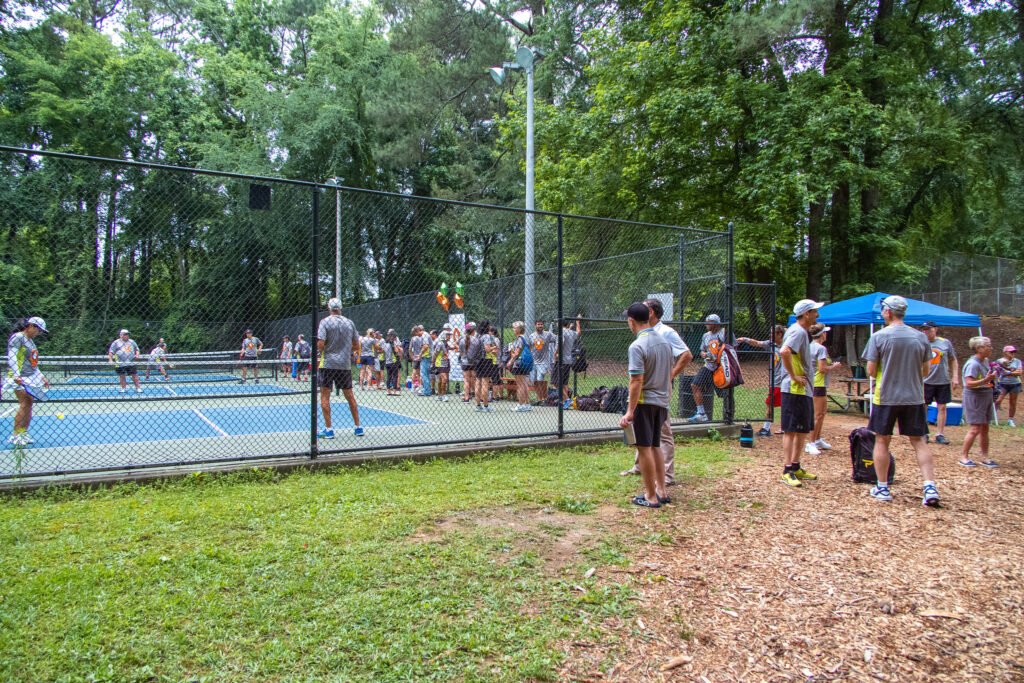
How to Build an Outdoor Pickleball Court?
Building an outdoor pickleball court involves several steps. Here’s a general guide:
Planning and Preparation for Pickleball Court
Choose the Location
When selecting an ideal location for a full-size pickleball court, finding a flat, unobstructed area measuring 34 feet wide and 64 feet long is paramount. The court’s dimensions are crucial for a regulation-sized playing area, ensuring that players have ample space for engaging gameplay while adhering to official standards.
Choosing a flat surface is vital to prevent unevenness that could affect gameplay or pose safety risks. The absence of obstructions such as trees, large rocks, or any structures within the court’s perimeter is equally essential to creating an unobstructed environment conducive to gameplay.
Additionally, ensuring sufficient clearance around the court is imperative. Recommended guidelines include providing at least 10 feet of space beyond the sidelines and baselines. This clearance facilitates unrestricted movement for players, preventing any hindrances while retrieving balls and avoiding collisions with surrounding objects or barriers.
By securing a designated area meeting these dimensions and clearance requirements, you create an optimal space for a full-size pickleball court. This thoughtful planning not only contributes to the court’s functionality but also enhances safety and the overall experience for players and spectators alike.
Check Regulations
Before embarking on the construction of an outdoor pickleball court, it is imperative to diligently verify local zoning laws, permits, and regulations pertaining to outdoor recreational facilities. Various municipalities and local governing bodies may have specific guidelines and ordinances regarding the construction of such amenities.
Start by contacting the local city or county planning department to inquire about the necessary permits and zoning regulations applicable to outdoor recreational facilities like pickleball courts. They can provide information regarding specific requirements, setbacks, size limitations, and any restrictions on court construction in residential or public areas.
Additionally, certain neighborhoods or homeowner associations might have their own set of rules and architectural guidelines governing property modifications, including the installation of sports courts. It’s crucial to understand and comply with these regulations to avoid potential legal issues or fines.
Engaging with local authorities, obtaining the required permits, and adhering to zoning laws not only ensures legal compliance but also guarantees the safety and appropriateness of the construction project within the designated area. By understanding and following these regulations, you can confidently proceed with the construction of your pickleball court while respecting the local community and its regulations.
Materials and Equipment
When embarking on the construction of an outdoor pickleball court, gathering the essential materials and tools is paramount to ensure a smooth and efficient building process. Here’s a comprehensive list of necessary items:
Paint
High-quality paint specifically designed for outdoor sports courts is crucial. Opt for durable, weather-resistant paint in appropriate colors for marking court lines and boundaries.
Fencing
Consider durable fencing materials to enclose the court area. Mesh wire or vinyl-coated chain-link fences are common choices, providing boundaries and containment for stray balls.
Posts
Sturdy and appropriately sized posts are necessary to support the net. Choose durable materials like steel or aluminum and ensure they’re of suitable height to meet regulation standards.
Nets
Invest in a regulation-size pickleball net made from durable materials to withstand outdoor conditions. Ensure it’s adjustable for correct height and tension.
Tools
Essential tools include a measuring tape for accurate dimensions, stakes to mark boundaries, a level for ensuring a flat surface, and a roller for proper adhesion of paint on the court surface. Additional tools like a chalk line, paintbrushes, and a cordless drill may also be beneficial for precise markings and installation.
Having these materials and tools ready before commencing the construction process ensures that you have everything necessary to create a high-quality pickleball court that meets standards, durability, and playing satisfaction.
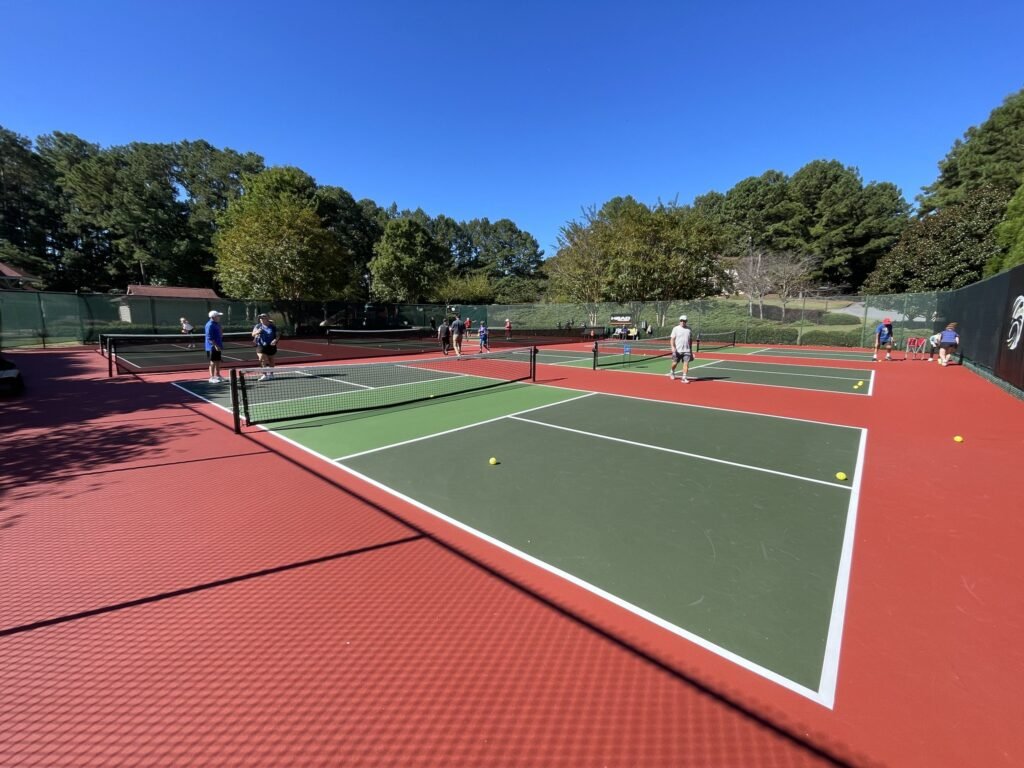
Construction Steps
Prepare the Surface
Preparing the area for a pickleball court involves meticulous steps to ensure a smooth and durable playing surface. The initial phase begins with clearing the designated area of any debris, rocks, or vegetation that might impede the construction process or compromise the court’s integrity. This step not only provides a clean canvas for construction but also eliminates potential hazards during gameplay.
Next, grading the surface is imperative to achieve a level base for the court. This process involves shaping and leveling the ground to eliminate slopes or unevenness, ensuring a uniform playing surface. Proper grading is vital as it lays the foundation for a well-constructed court and aids in effective drainage, preventing water accumulation that could lead to puddles or damage to the court surface over time.
Once the surface is properly graded, selecting the base material is a crucial decision. Materials like asphalt, concrete, or a compacted stone/gravel base are commonly used for their durability and stability. These materials provide a solid foundation that supports the court structure and helps maintain its integrity against wear and tear caused by gameplay and weather elements.
The choice of base material should align with factors such as budget, climate conditions, and intended usage of the court. Properly executed clearing, grading, and base installation are fundamental steps that significantly contribute to the longevity and performance of the pickleball court.
Mark the Court
To delineate a pickleball court accurately, precise measurements are essential. Using chalk or marking paint, designate the court’s dimensions on the ground. Employ a long tape measure and stakes to ensure accuracy throughout the process.
For singles play, a standard pickleball court measures 20 feet in width and 44 feet in length. In contrast, for doubles play, the court remains 20 feet wide but reduces in length to 22 feet. Additionally, a 7-foot non-volley zone, often referred to as the “kitchen,” is established on each side of the net.
The meticulousness in marking these measurements is crucial, as it not only defines the playable area but also ensures adherence to official court dimensions, fostering fair and consistent gameplay. The sidelines, baselines, and non-volley zones must be accurately marked to delineate boundaries and critical areas within the court.
Using the tape measure as a guide and securing stakes at precise intervals assists in maintaining straight lines and proper angles, thereby guaranteeing a well-defined and regulation-compliant pickleball court. This precision in measurement and marking sets the foundation for a high-quality court that enables players to enjoy the sport to its fullest extent.
Install Fencing and Posts (Optional)
Installing fencing around the perimeter of a pickleball court serves multiple purposes crucial to the playing environment. The fencing acts as a containment barrier, preventing stray balls from disrupting neighboring areas and defining the precise boundaries of the playing space. This containment not only ensures a more seamless game but also minimizes interruptions caused by errant shots, keeping the focus squarely on the game at hand.
When setting up posts to hold the net, the emphasis lies on creating a stable and secure structure. Sturdy posts are vital to maintaining the net at the required height and tension, crucial for the integrity of the game. Ensuring these posts are firmly anchored into the ground contributes to the stability of the net, minimizing potential sagging or swaying during gameplay. Additionally, securely anchored posts add to the safety of the court, reducing the risk of accidental dislodging or collapsing during intense rallies.
Both elements, the perimeter fencing and net posts, are integral components that contribute not only to the functional aspects but also to the aesthetics of the pickleball court, providing a well-defined and contained space for an enjoyable and uninterrupted game.
Painting the Lines
When marking lines on a pickleball court, precision and accuracy are paramount to ensure adherence to official regulations and a professional appearance. Painter’s tape or stencils serve as indispensable tools for achieving straight, consistent lines on the court surface. These tools aid in delineating the boundaries, non-volley zone, and other designated lines necessary for gameplay.
Once the lines are accurately marked, the next step involves applying the appropriate paint to finalize the court’s appearance. Typically, white paint is used for delineating boundaries and various lines on the court, providing high visibility against the contrasting surface.
The process of painting the lines involves meticulous attention to detail, ensuring crisp and uniform lines throughout the court. Quality paint designed for outdoor sports surfaces is recommended to withstand weather conditions and regular gameplay. Applying multiple coats may be necessary to achieve optimal coverage and durability, maintaining the lines’ clarity over time.
By using painter’s tape or stencils and employing the correct paint for the lines, the finished court not only meets official standards but also enhances the playing experience, offering clear and defined boundaries that contribute to the game’s integrity and enjoyment for players of all skill levels.
Net Installation
Setting up the net for a pickleball court requires precision to meet regulation standards and ensure fair gameplay. Begin by attaching the net to the posts, securing it at the designated heights – 36 inches at the sidelines and 34 inches at the center. This difference in height is intentional, creating a slight slope that helps with ball visibility and fair play during rallies.
To achieve the correct height, utilize measuring tools to confirm the net’s alignment with the specified measurements. Once attached, adjust the tension evenly on both sides to ensure the net is taut and free from sagging. Proper tension is crucial as it prevents the ball from rebounding incorrectly and ensures that players experience a consistent bounce during play.
To achieve optimal tension, start from the center and work outward, making gradual adjustments on both sides of the net. This process ensures uniform tension along the entire length of the net. Regular checks and fine-tuning might be necessary during initial setup and periodically during use to maintain the correct tension, especially in outdoor environments where weather conditions can affect the net’s tightness.
By meticulously following these steps, you’ll ensure that the net meets the prescribed standards, enhancing the playing experience by providing a fair and consistent barrier that upholds the integrity of the game.
Finishing Touches
Before finalizing the construction of your outdoor pickleball court, it’s imperative to meticulously review all measurements and markings for precision and compliance with official standards. Double-checking the court’s dimensions, boundary lines, and the placement of the non-volley zone ensures that the playing area aligns with regulatory requirements, guaranteeing a fair and consistent playing experience for all participants.
Once the measurements are confirmed, the next crucial step is to eliminate any excess debris or obstructions from the court surface. This includes removing rocks, branches, loose gravel, or any other items that could impede gameplay or pose safety hazards to players. Thoroughly cleaning the court surface not only enhances the aesthetic appeal but also prevents potential injuries and maintains the court’s integrity.
By meticulously verifying measurements and markings for accuracy and diligently clearing the court surface of debris, you’re ensuring a professionally finished pickleball court ready for countless hours of enjoyable play. These final steps are instrumental in guaranteeing a well-maintained, safe, and inviting environment for pickleball enthusiasts to relish their game to the fullest.

Additional Considerations
Maintenance
Regular inspection of your pickleball court is essential to maintain its quality and safety standards. Check the surface for any signs of wear, cracks, or damage, as these issues can affect gameplay and pose safety risks. Conduct routine assessments, particularly after heavy use or harsh weather conditions, to identify any potential problems.
Address any cracks promptly by repairing or resurfacing the affected areas to prevent further deterioration. Additionally, regularly repaint the court lines as needed to ensure visibility and adherence to official dimensions.
Maintaining the court’s integrity not only prolongs its lifespan but also guarantees a safer and more enjoyable playing environment. By staying proactive with inspections and timely repairs, you can preserve the quality of your pickleball court for years to come, enabling continuous play and minimizing the need for extensive renovations.
Safety
Creating a safe playing area for pickleball is paramount to ensure an enjoyable and risk-free experience for players. Start by inspecting the entire court area and its surroundings to eliminate potential hazards. Ensure the playing surface is even, free from cracks, debris, or slippery substances that could cause players to trip or fall. Adequate lighting for evening games is essential to enhance visibility and prevent accidents.
Additionally, installing proper fencing or barriers around the court periphery helps contain stray balls, preventing them from causing interruptions or accidents. Providing clear signage regarding court rules, safety guidelines, and the location of emergency equipment can further enhance safety measures.
Regular maintenance routines, such as inspecting the court for wear and tear, repairing any damages promptly, and keeping the area clean and well-maintained, are crucial to uphold safety standards. By prioritizing these measures, players can engage in the sport confidently, minimizing the risk of injuries and maximizing their enjoyment on the court.
Accessibility
In addition to the core construction of a pickleball court, thoughtful consideration of amenities enhances the overall playing experience for both participants and spectators. Access paths leading to the court should be clear, well-defined, and easily accessible, ensuring convenience and safety for players carrying equipment or individuals with mobility aids.
Seating arrangements play a vital role in providing comfort and relaxation for players between games and spectators observing the matches. Installing benches or seating areas along the court perimeter allow for rest and create a welcoming environment for onlookers.
Furthermore, amenities such as shade structures, water stations, and storage facilities for equipment contribute significantly to the convenience and enjoyment of everyone involved. Providing these supplementary features elevates the appeal of the pickleball court, fostering a more inclusive and inviting space for players and spectators alike.
Before embarking on your pickleball court construction project, seeking guidance from professionals or local experts is highly advisable. Consulting with individuals well-versed in construction, outdoor recreation facility standards, and local regulations is crucial for ensuring your court aligns with all requirements.
Professionals can offer invaluable insights into the specific guidelines, permits, and zoning regulations applicable to outdoor recreational facilities in your area. Their expertise can help navigate potential pitfalls, ensuring your project complies with safety standards and legal obligations.
Moreover, consulting with experts can provide valuable advice on the technical aspects of construction, including surface preparation, court dimensions, drainage considerations, and material choices. Their input can significantly contribute to the successful planning and execution of your pickleball court, guaranteeing it meets the requisite standards for a safe and enjoyable playing experience.
